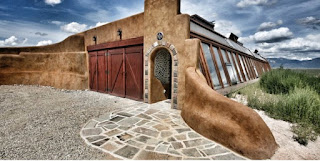OUR FIRST STOP: EARTHSHIP BIOTECTURE CENTER, Taos, New Mexico
 Our visit to the Earthship Biotecture Center near Taos, New Mexico was an amazing learning experience we can highly recommend to anyone interested in alternative energy and sustainable living.
Our visit to the Earthship Biotecture Center near Taos, New Mexico was an amazing learning experience we can highly recommend to anyone interested in alternative energy and sustainable living.Michael Reynolds, profiled in the outstanding Sundance TV Channel documentary Garbage Warrior (see the trailer on YouTube), has created a community of beautiful homes and multi-purpose buildings you can tour that are ecological marvels. Visit their website at EarthshipGlobal.com. Also check out the Democracy Now segment about Mike Reynolds with Amy Goodman, also on YouTube.
Many of these homes are lived in and others are AirBnB rentals.
We stayed in the beautiful Waybee House and loved it (see it on YouTube). We also took the guided tour of other homes and buildings. They were all beautiful and inspiring examples of what is possible in creating nonpolluting, self-sufficient, resource-efficient construction for all purposes that can be tailored to any place, in any climate and to any budget.
Each “Earthship” building is unique, but they all have these features in common:
1. An Earthship is made of recycled materials, such as tires, bottles, aluminum cans and even clothing for insulation. See more about this on YouTube.
Earthship | New Solutions [Guide]
and
Earthship Academy
2. Each one uses electricity from the sun and wind (solar panels and wind modules) and fully utilizes an efficient south-facing passive solar design featuring a greenhouse that is part of the house!
3. Water is caught on the roof from rain and snow melt and stored in cisterns.
4. Sewage is treated on site in both interior and exterior botanical planters along with a traditional septic tank.
5. Heating and cooling is from the sun and earth using thermal mass construction and internal “cooling tubes” that regulate temperature.
6. Food may be grown inside and out.
The Waybee House we stayed in was completely off the grid, but did have the convenience of a beautiful propane stove and a full size refrigerator/freezer that runs on DC current. It also had a full size washer and dryer. This was not a hippie hovel by any standard. In fact, it had every creature comfort you could imagine, including a solar powered TV and DVD player.
The Garbage Warrior documentary chronicles Mike Reynolds' 40-year odyssey building these marvelous structures. He earned the "hero" moniker as he was summoned to disaster sites around the globe and successfully demonstrated how diverse societies can build good quality, sustainable shelter in devastated areas using garbage such discarded tires, cans and bottles.
Now his struggle is to create the legal right to experiment with his many burgeoning new ideas. You can also see these new concepts on site as part of the tour.
If you can’t get to New Mexico or any of the other places that he and his crew have graced with his work around the world, there are many beautifully illustrated, fully detailed, easy to comprehend books, DVDs and other materials that make this all easy to take in. So inspiring is this place, we hope to see the New Mexico Center declared a UNESCO World Heritage Site, as it provides accessible, affordable answers to the world’s many problems of pollution and waste and the endless need for good quality shelter, efficient use and reuse of resources and community building.
OUR SECOND STOP:
KTAOS, Solar Powered Radio Broadcasting Company (KTAO 101.9 FM and Luna 96.7 FM).
Thirty-five years ago, a small radio station began along a dirt road in Taos, New Mexico. Since then, the station has grown into the world’s most powerful solar radio station.
KTAO received international attention when it became the first radio station in the world to be powered by the sun. A super-structure holding solar panels was installed and racks of batteries along with the transmission equipment were housed in an “earthship” made of recycled materials that maintains a safe, constant temperature range year round.
In 1996, KTAO grew again, adding staff and doubling the size of its building on Blueberry Hill Road. In 1997, they began the KTAOS Solar Music Festival, which attracted an audience of thousands. The show was renamed the Taos Solar Music Festival in 1999 and over the next ten years Solar Fest became an internationally recognized event that continues to grow in popularity.
What’s Solar Radio?
In 1991, KTAO installed a structure holding 150 solar panels on the top of Picuris Peak. Racks of batteries along with the transmission equipment were housed in a self-sustaining Earthship – a partially underground building constructed of tires, rammed earth and other recycled materials – that maintains a constant and safe temperature range year round. Over the past 20 years, the number of solar panels has grown and KTAO is now licensed at 100,000 watts, earning it the title of the world’s most powerful solar powered radio station. 50,000 watts is considered big in solar radio, making KTAO huge in comparison. The photovoltaic panels are virtually maintenance free and cut the electric bill to almost nothing, while allowing KTAO the capability to transmit over a 100-mile radius from Taos. KTAO has not only made a commitment to bringing a great variety of music to the Taos community, but on a larger scale, it is committed to making a lasting difference on the planet with its use and advocacy of solar power.
Learn more and listen at their website, The KTAOS Solar Center
OUR THIRD STOP: TAOS NATIVE AMERICAN PUEBLO, Taos, New Mexico
We thoroughly enjoyed our visit to this beautiful place, which is a premiere and outstanding historic example of sustainable living! Taos Pueblo (TaosPueblo.com) is the only living Native American community designated both a World Heritage Site by UNESCO and a National Historic Landmark. Taos Pueblo has been inhabited continuously for over 1,000 years, keeping alive vibrant Native American tradition, culture and cuisine!
The Pueblo is made entirely of adobe — earth mixed with water and straw, then either poured into forms or made into sun-dried bricks. The walls are frequently several feet thick. The roofs of each of the five stories are supported by large timbers — vigas — hauled down from the mountain forests. Smaller pieces of wood — pine or aspen latillas — are placed side-by-side on top of the vigas; the whole roof is covered with packed dirt. The outside surfaces of the Pueblo are continuously maintained by replastering with think layers of mud. Interior walls are carefully coated with thin washes of white earth to keep them clean and bright. The Pueblo is actually many individual homes, built side-by-side and in layers, with common walls but no connecting doorways. In earlier days there were no doors or windows and entry was gained only from the top.
Beautiful mud adobe-built outdoor ovens called hornos are used by Native Americans. The horno has a beehive shape and uses wood as the heat source.
Indoors, the pueblo uses kiva fireplaces for warmth and cooking. Crafted from adobe, a Spanish term meaning mud bricks, it is placed in a corner. A kiva’s adobe walls radiate heat and provide cozy warmth to a room.
Often known as “beehive fireplaces” due to their distinctive shape, the characteristic broad base of a kiva fireplace allows more heat to radiate around the bottom, making it more energy efficient. The narrow top allows fumes to exit out the upper flume opening. Conventional features of the kiva fireplace include nichos and bancos. A nicho is a recessed shelf cut out of an adobe wall. Small art objects, pictures or other decorative items can be displayed. A banco is a bench built on one or both sides of the kiva fireplace.
Archaeologists say that ancestors of the Taos Indians lived in this valley long before Columbus discovered America and hundreds of years before Europe emerged from the Dark Ages.
Again, anyone interested in sustainable architecture will be inspired by visiting the beautiful historic Taos Pueblo in New Mexico.

























